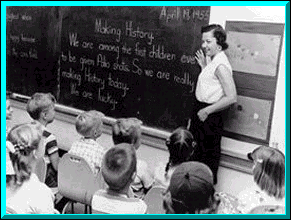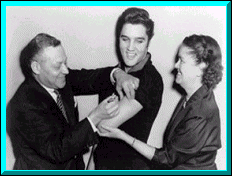Edward R. Murrow: Who owns the patent on this vaccine?
Jonas Salk: Well, the people, I would say. There is no
patent. Could you patent the sun?
See It Now, April 12, 1955
quoted in
Patenting the Sun:
Polio and the Salk Vaccine
page 1 | page
2 | page 3 | page 4
The data was in by October, but tabulation took a long time, and it was
March before they could begin the analyze the results. The National Foundation began
to worry. They had to have the results by mid-April. Otherwise, if the vaccine
worked, there would be no way to manufacture and distribute it in time for the summer
polio season. It took three weeks to analyze the data. The computers of the
time were very, very slow.
The decision was made to hold a scientific conference at the University of
Michigan, home of the Vaccine Evaluation Center, on 12 April 1955. It was an
accident that the date was the tenth anniversary of Roosevelt's death.
The report for the conference, An Evaluation of the 1954 Poliomyelitis
Vaccine Trials was finished on 11 April. It consisted of fifty pages of text
and an even longer appendix of tables and charts. The first ten pages were a list of
all of those people who had supervised different parts of the evaluation and all of the
organizations that had helped with either services or volunteers. The National
Foundation wanted to see that everyone was thanked properly for their work. The
paper did not have an author listed. Instead, it said that it came from the
Poliomyelitis Vaccine Evaluation Center at the University of Michigan, sponsored by the
National Foundation for Infantile Paralysis. In effect, it was as if every person
who had contributed to the March of Dimes had helped to write this report.1
Somehow, though, this scientific conference became a press conference.
The press packed into Ann Arbor, well over one hundred reporters. They came
from as far away as France, Denmark, and Italy. The plan had been to distribute the
press release from five separate tables to prevent crowding, but the reporters mobbed the
publicists at the elevator. "It works! It works!" they
shouted. They struggled to call out and dictate their stories. One reporter
climbed out a window with his phone to file his report from the quiet of the roof.2
The newspapermen had to wait for the presses, but radio and television
people didn't. And around the world, people waited by their radios. In Europe,
people tuned into Voice of America. Trials were halted, department stores set up
speakers, Helen Hayes took the morning off from rehearsals to hear.3
And when the news was heard, the fire sirens blew again and the church bells rang
again, and the people took to the streets again, this time to dance and sing and shout and
clap their hands.
Downstairs, unaware of the national celebration already underway, the
scientific conference was in progress. And here the real results were
announced. The vaccine was 60-70% effective against type I paralysis. It was
over 90% effective against type II and type III. And, it was 94% effective against
bulbar polio, the type that affected breathing.4 People
applauded politely for that news, but they gave thunderous applause to the next speaker,
the man everyone associated with the wonderful news: Dr. Jonas Salk.

Making History
We are among the first children ever
to be given Polio shots. So we are really
making history today.
We are lucky.
Around the country, labs began to produce polio vaccine and deliver it to doctors.
Then, disaster struck. The polio vaccine manufactured by Cutter Laboratories in
Berkeley, California, had been improperly inactivated. It contained live
poliovirus. Two hundred four people contracted polio from the bad vaccine, over one
hundred fifty were paralyzed, and eleven died.5
The Cutter vaccine was recalled, but the vaccinations with other batches continued.
The vaccine was in short supply. By 1957, when it was widely available,
though, no one seemed interested. It was odd, but it was almost as if people thought
the existence of the vaccine was enough to protect them, whether or not they ever
got inoculated. The National Foundation had to launch a new publicity campaign to
promote the vaccine.

Elvis takes a needle to promote teenage vaccination.
page 1 | page
2 | page 3 | page 4


Footnotes
1. Smith, Jane S. Patenting the Sun: Polio and the
Salk Vaccine. New York, New York: William Morrow and Company, Inc.
1990. pp. 305-312.
2. idem. pp. 317-318.
3. idem. p. 319.
4. idem. p. 322.
5. "Polio History Timeline (1955)." A
Paralyzing Fear: The Story of Polio in America. http://www.pbs.org/storyofpolio/polio/timeline/1955.html.
(5 May 1999). |
